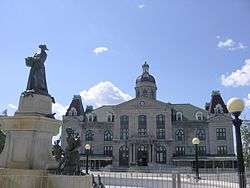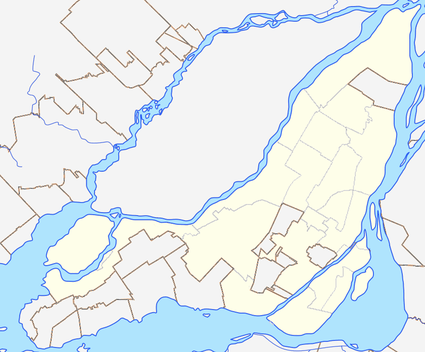Hochelaga-Maisonneuve
Hochelaga-Maisonneuve (French pronunciation: [ɔʃlaɡa mɛzɔ̃nœv]) is a neighbourhood in Montreal, Canada, situated on the eastern half of the island, generally to the south and southwest of the city's Olympic Stadium. A part of the borough of Mercier–Hochelaga-Maisonneuve, its borders are roughly the train tracks west of Moreau Street to the west, Sherbrooke Street to the north, the train tracks east of Viau Street to the east, and the Saint Lawrence River to the south. Its population is a mix of working-class Québécois, students, and recent immigrants.
Hochelaga-Maisonneuve | |
|---|---|
 Marché Maisonneuve, in Hochelaga-Maisonneuve | |
 Hochelaga-Maisonneuve Location of Hochelaga-Maisonneuve in Montreal | |
| Coordinates: 45.57525°N 73.53325°W | |
| Country | Canada |
| Province | Quebec |
| City | Montreal |
| Borough | Mercier–Hochelaga-Maisonneuve |
Named after the First Nations village of Hochelaga, encountered in 1535–36 by the explorer Jacques Cartier, the neighbourhood was at one time believed to be the location of the prehistoric village. Historians and anthropologists have not reached agreement on the location of Hochelaga, a village of the St. Lawrence Iroquoians, who spoke a Laurentian language and were distinct from the Iroquois nations of the Haudenosaunee.[1]
Olympic Park, containing the Stadium, Olympic Tower, Saputo Stadium, Biodome, Olympic Pool, Maurice Richard Arena, and Parc Maisonneuve (located just across the border in the Rosemont La Petite Patrie borough), offer recreation for locals and tourists.
Education
The Commission scolaire de Montréal (CSDM) operates French-language public schools.
The English Montreal School Board (EMSB) operates English-language schools.
The Montreal Public Libraries Network operates the Hochelaga and Maisonneuve libraries.
See also
- Hochelaga, federal electoral district
- Hochelaga-Maisonneuve, provincial electoral district
- East End Forever, a documentary film about seven young people from the district
References
- Bruce G. Trigger, "The Disappearance of the St. Lawrence Iroquoians", in The Children of Aataenstic: A History of the Huron People to 1660, vol. 2], Montreal and London: Mcgill-Queen's University Press, 1976, pp. 214-218, accessed 2 Feb 2010
External links
| Wikisource has the text of the 1921 Collier's Encyclopedia article Maisonneuve. |
